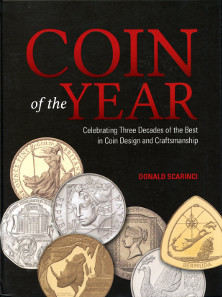by Ursula Kampmann
translated by Annika Backe
July 30, 2015 – Strictly speaking, there is hardly any need to introduce the Coin of the Year Award, the archetype of awards for newly issued coins, which Krause Publications has awarded for the first time in 1984, in order to motivate all mints to report their new releases, to be listed in the Krause catalogs.
Donald Scarinci, Coin of the Year – Celebrating Three Decades of the Best in Coin Design and Craftsmanship. Krause Publications, Iola, 2015. 143 pages, colour illustrations throughout. Hardcover, 21 x 28 cm. ISBN 978-1-4402-4476-6. 23.25 $.
By now, the COTY has gained such great a reputation that it has become a collecting area of its own. Hence, the latest publication of Krause is a useful tool to establish one’s own collection of winner coins. On the other hand, this book is a marvelous testimony to the change minting underwent in the previous three decades.
The structure of the book is rather straightforward: it is arranged according to years. Each winning coin is illustrated on an introductory page, accompanied by a comment. The next pages include the winners of the other categories, all shown in the same size, with a diameter of nearly 6 centimeters. Anyone looking for more information on the coins has to go to the catalog, arranged according to countries, to be found at the end of the book. All coins – not accompanied by illustrations in this part – are listed and described Krause-style: KM number, denomination, weight, material, diameter, short description (and I do mean ‘short’), year, mintage – as far as is known, valuation for the different grades (for F12, VF20, XF40, MS60 und MS63, following the American system).
It is significant for international numismatics how quickly the United States of America have been caught up by other states as supplier of the Coin of the Year. While the first two winners came from the USA, Canada came off victorious when the prize was awarded the third time. And while Finland was more or less still among the outsiders when it was awarded Coin of the Year in 1987, those outsiders began to be on the increase as of 1993.
Anybody interested in minting technology will likewise appreciate this book for it allows keeping track of bi-metallic and tri-metallic coins, how they became established and how their novelty value was diminished by objects with colored ink, non-metallic inlays and distinct shapes.
The reader soon realizes which countries stand for which innovations. Yet this is where the catalog’s author, Donald Scarinci, has made a crucial mistake: the name of the manufacturing mint is only rarely given, though it is exactly the innovative coins, which are often made for the collector – with such exotic destinations as Ivory Coast, British Indian Ocean Territory or Mongolia –, where the nominal state does not matter at all, quite contrary to the mint or the commissioning marketing company.
This is a pity for this information is vital for understanding where the providers of ideas are located.
Anyhow, it is a nice book that erects a memorial in contemporary numismatics’ honor. The fact that it does not provide more in depth-information is a pity considering that contemporary numismatics, too, is a subject that deserves to be treated more thoroughly.





